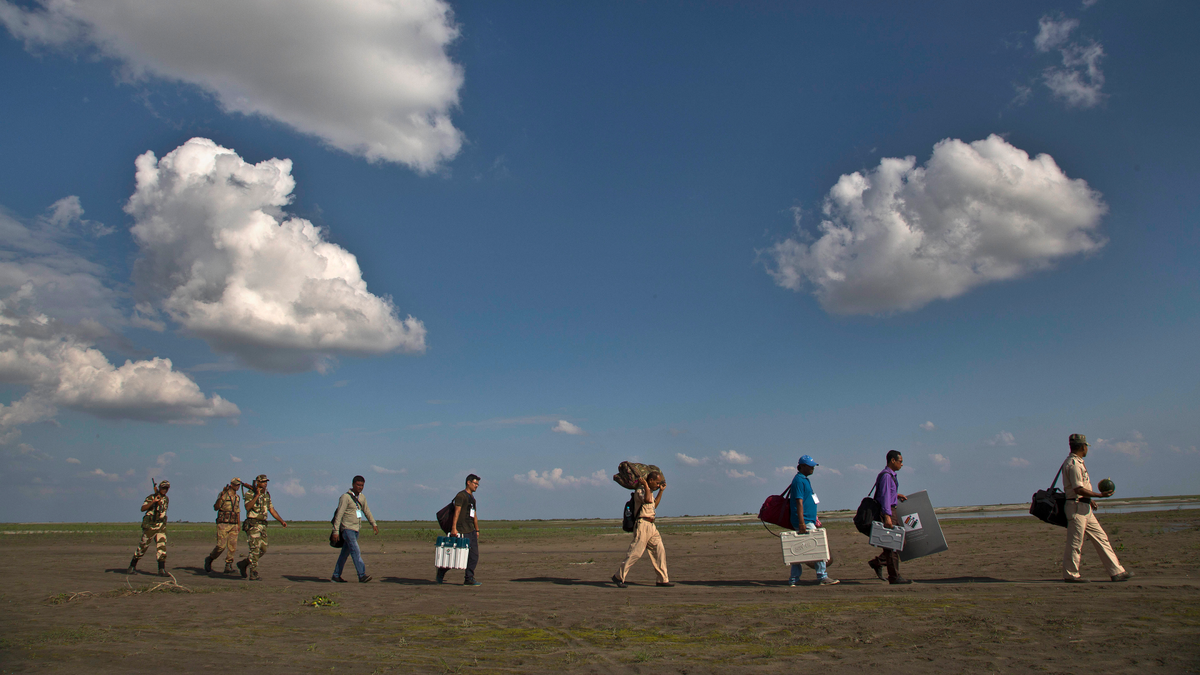
In this April 10, 2019, photo, Indian election officials and paramilitary soldiers with election materials walk along the river Brahmaputra to board on a country boat on the eve of the first phase of general election in Majuli, Assam, India. (AP Photo/Anupam Nath, File)
NEW DELHI – The figures involved in India's general election are staggering: 900 million voters, 83 million first-time voters, 11 million poll workers, nearly 4 million electronic voting machines, 1 million polling booths and 570 special trains for migrant laborers and security personnel.
Such numbers convey the scale of the world's biggest democratic exercise. But its smaller numbers that show India's commitment to reach every voter, no matter how remote.
In India's six-week marathon election that began this week, the Election Commission has ruled that no voter should have to travel more than 2 kilometers, or just over a mile, from their home to cast a ballot, whether they live on a Himalayan peak or an island in the Bay of Bengal.
The polling booth in Gir Forest National Park in Gujarat is set up for the sole human inhabitant, a Hindu priest who lives among the lions. Polling officials hike for a whole day to reach the remote village of Malogam in Arunachal Pradesh, where just one woman is registered to vote.
Poll workers must be in superb physical condition to cross mountains, rivers, deserts, forests and national parks. The work entails arduous journeys by train, road, helicopter and boat, accompanied by porters who carry the briefcase-sized voting machines, registers, ink and other election paraphernalia on their backs.
In Arunachal Pradesh, a state in India's northeast that borders Bhutan, China and Myanmar and where voting took place Thursday, most polling stations are located inside dense, Himalayan forest.
Poll workers set off a week before the vote. The first leg of the journey was a three-hour drive from Changlang, a district in the east, to the city of Maio, a tourist destination 100 kilometers (62 miles) away.
From Maio, the next stop was Vijoynagar, some 163 kilometers (101 miles) away, via the Namdapha National Park. No road connects the two towns, and the terrain is subject to frequent flash floods and landslides. Journeys here are measured in days rather than hours.
So, the team reached Vijoynagar by Indian Air Force helicopter. In pre-monsoon time, bad weather can force the pilot to abort several attempts. That's why a week's leeway is given to the team. If all else fails, it's six days to reach Vijoynagar by foot.
From Vijoynagar, the caravan walked the final leg of their odyssey to the polling station of Gandhigram. It is only 12 kilometers (7.5 miles) from Vijoynagar but the trek takes eight hours, through eerily dark jungles where no sunlight steals through the canopy and under constant threat of an ambush by a herd of elephants.
Majestic gorges were crossed on casually strung, flimsy bamboo suspension bridges that wobble like jelly in strong winds. The team traveled with torches, water filters and emergency lights, and a local guide who knows the jungle.
"These are not Alpine tracks. These are sub-tropical forests with thick undergrowth. There is no stated rule, but we prefer people under 45 because a lot of stamina and energy are required," said Kaling Tayeng, the chief electoral officer of Arunachal Pradesh.
The marathon expedition to Gandhigram was all for 242 voters.
In the Ladakh region of Indian-controlled Kashmir in the north, a polling station at an altitude of 4,327 meters (14,196 feet) is being set up for only 12 voters.
Another Ladakh station, Anlay Pho, is so high at 4,500 meters (almost 15,000 feet) above sea level that polling teams must carry oxygen tanks.
When Winston Churchill described India as a "geographical expression" no more a united nation than the equator, he was speaking to the diversity in landscapes that makes the Election Commission's job so challenging.
At the other extreme of the country from the mountain peaks of Ladakh are the low-lying Andaman and Nicobar Islands where voting machines were transported by various seafaring vessels for Thursday's vote.
The polling station at Pilopatia, just 9.7 meters (32 feet) above sea level, is famous for the trouble it presents election officials.
Officials start off on a 24-hour by ship journey from Port Blair, then by speedboat, then by small dinghy and finally by a "hodi," or traditional boat used by the local tribe, said Dr. Monica Priyadarshini, a Nicobar district election officer.
"In places, the waters are infested with crocodiles and sea snakes," Priyadarshini said.
The voting machines were protected inside waterproof boxes and other polling material was kept dry under layers of plastic cover. The journey ended with a splash: Priyadarshini and the team clambered out and waded through waist-high water to reach the shore. All this for just nine voters.
Many polling booths in remote areas have no mobile connectivity. Here too, the team had to use wireless sets and satellite phones to send the commission's mandated twice hourly reports on the progress of polling.
"I had voted in elections, but I never had any idea of the work that goes into ensuring that every single vote is cast," Priyadarshini said.
In Chhattisgarh, central India, where some polling stations were open this week, it is both geography and ideology that present problems. The jungles are thick with vegetation and teeming with Maoist insurgents called Naxalites who attack government officials with bullets, incendiary devices and land mines.
Earlier this week, insurgents attacked a convoy of India's ruling Bharatiya Janata Party, killing a state party lawmaker and four other people in his vehicle with an improvised explosive device.
"We had 100 high security zones that are very dangerous. In some of them, over 100 security personnel accompanied just 20 polling officials to secure their path through the forest," said Chhattisgarh police chief Durgesh Kumar Awasthi. "My men haven't slept for days."
